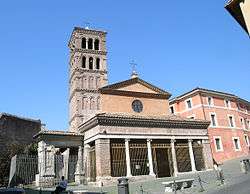San Giorgio in Velabro
San Giorgio in Velabro is a church in Rome, Italy, devoted to St. George.

The church is located next to the Arch of Janus in the rione of Ripa in the ancient Roman Velabrum. According to the founding legend of Rome, the church was built where Roman history began: it is here that the she-wolf found Romulus and Remus.[1] The ancient Arcus Argentariorum is attached to the side of the church's façade.
San Giorgio in Velabro is the station church for the first Thursday in Lent.
History
The first religious building attested in the place of the current basilica is a diaconia, funded by Pope Gregory the Great.
The current church was built during the 7th century, possibly by Pope Leo II, who dedicated it to Saint Sebastian. A 482 inscription in the catacombs of St. Callixtus probably refers of a church in the same zone. Its plan is irregular, indeed slightly trapezoidal, as a result of the frequent additions to the building. As can be seen from the lower photograph, the interior columns are almost randomly arranged having been taken from sundry Roman temples.
The church was inside the Greek quarter of Rome, where Greek-speaking merchants, civil and military officers and monks of the Byzantine Empire lived — the nearby Santa Maria in Cosmedin, for example, was known as in Schola Graeca at the time. Pope Zachary (741-752), who was of Greek origin, moved the relic of St. George to here from Cappadocia, so that this saint had a church dedicated in the West well before the spreading of his worship with the return of the Crusaders from the East.
After a restoration of Pope Gregory IV (9th century), the church received the addition of the portico and of the tower bell in the first half of the 13th century. The apsis was decorated with frescoes by Pietro Cavallini in the 13th century.
In 1347, the Roman patriot Cola Di Rienzo posted a manifesto announcing the liberation of Rome on the doors of this church.[2]
Between 1923 and 1926, the Superintendent of Monuments of Rome, Antonio Muñoz, completed a more radical restoration programme, with the aim of restoring the building's "medieval character" and freeing it from later additions. This was done by returning the floor to its original level (and so exposing the column bases) reopening the ancient windows that gave light to the central nave, restoring the apsis, and generally removing numerous accretions from the other most recent restorations. During this process, fragments (now displayed on the internal walls) were found indicating a schola cantorum on the site, attributed to the period of Gregory IV.
The building as we see it today is largely a product of the 1920s restoration. However, five years' further restoration followed the explosion of a car bomb, parked close to the facade, at midnight on 27 July 1993. That explosion caused no fatalities but left the 12th century portico almost totally collapsed and blew a large opening into the wall of the main church, as well as doing serious damage to the residence of the Generalate of the Crosiers (Canons Regular of the Order of the Holy Cross) next door. The Ministry of Cultural Heritage researched and catalogued what was damaged or destroyed, placing the fragments in 1050 crates with dates and locational references before restoring the building with them, although some details, particularly in the portico, were deliberately left unrestored as a memorial to the bombing.
Cardinal-Deacons
The church was established as a Deaconry by 590 A.D., the reign of Pope Gregory I. Among the previous titulars are;
- Giacomo Stefaneschi (1295–1341)
- Oddone Colonna (1405–1417), later Pope Martin V.[3]
- Raffaele Riario (1477–1480)[4]
- Giovanni Antonio Serbelloni (1560–1565)
- John Henry Newman (1879–1890)[5]
- Cardinal Alfons Maria Stickler (titular) until his death in 2007
Since November 2010, Gianfranco Ravasi has been Cardinal-Deacon of the church.
References
- History of the Church of San Giorgio in Velabro, The attack of July 1993 http://www.sangiorgioinvelabro.org/eng/storia.html
- Medieval history site.
- Conradus Eubel, Hierarchia catholica medii aevi I, editio altera (Monasterii 1913), p. 50.
- Conradus Eubel, Hierarchia catholica medii aevi II, editio altera (Monasterii 1914), p. 66.
- "San Giorgio in Velabro". Catholic-Hierarchy.org. David M. Cheney. Retrieved 21 January 2015.
Bibliography
| Wikimedia Commons has media related to San Giorgio in Velabro (Rome). |
- Federico di San Pietro, Memorie istoriche del sacro tempio, o sia Diaconia di San Giorgio in Velabro (Roma: Paolo Giunchi 1791).
- Antonio Muñoz, Il restauro della basilica di S. Giorgio al Velabro in Roma (Roma: Società editrice d'arte illustrata, 1926).
- A. Giannettini and C. Venanzi, S. Giorgio al Velabro (Roma: Marietti, 1967).
- Maria Grazia Gurco, "The Church of St. George in Velabrum in Rome: techniques of construction, materials and historical transformations," Proceedings of the First International Congress on Construction History (ed. Santiago Huerta) (Madrid 2003) Vol. 3, pp. 2009-2013.
External links
- Sketch of S. Giorgio (ca. 1900)
- High-resolution 360° Panoramas and Images of San Giorgio in Velabro | Art Atlas
- The History of the Church of San Giorgio in Velabro
See also
St George's Church (disambiguation), for a list of other churches worldwide of the same name.